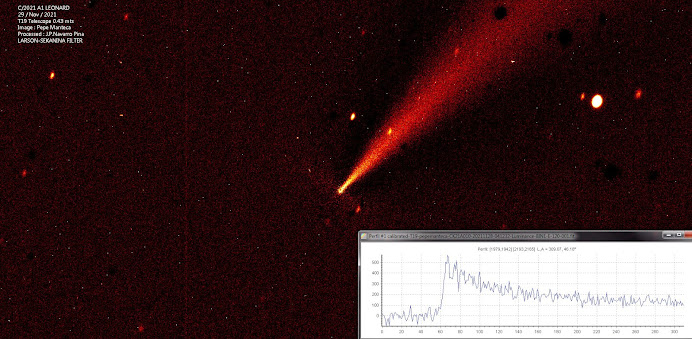Comet Leonard quickly loses brightness, based on the latest visual observations of this comet, its latest report, is located at visual magnitude m1 = + 4.8, this means a rapid decrease in its rate of increase in brightness, and therefore in its gaseous and dusty activity, according to my calculation at a rate of 0.44 magnitudes per day, this is an excessive rate of decrease in brightness, after the burst of brightness, which took place a few days ago, specifically on December 14, Today the 19th, that is, 5 days later, the comet has lost 2.6 magnitudes, let's bear in mind that a jump of one magnitude is equivalent to a difference in brightness of 2.5 times (the fifth root of 100), so The comet in just 5 days, has varied approximately 6 times its difference in brightness, we can conclude that its period of visibility with the naked eye has been very short, according to my data, little more than a week ... however, it is still right now as bright as the comet 1 P / Halley in its appearance in 1986, I encourage all of you to keep trying to observe it, now that it is still relatively bright, remember, that it is already difficult to see comets of magnitude 5 as it is right now.
Graphic : COBS .
https://fb.watch/9_SXErxymp/
Sunday, December 19, 2021
UPDATE LEONARD COMET
Thursday, December 2, 2021
LARSON SEKANINA FILTER LEONARD COMET
Good morning before the doubts that this comet is offering, and the rumor that runs that it is disintegrating, I have used the larson sekanina filter, this filter calculates the radial and rotational gradient of an image. It is used to enhance the finest details in bright objects, exhibiting symmetry of revolution (elliptical galaxies and comet commas). This filter is very powerful to reveal internal details within the coma of bright comets (such as jets and shells), in the attached image not a single fragmentation detail is observed, only the ionic tail, in addition to that I have done to ensure even more, a GDP of the coma, in which there is no abrupt or strange change in it.
Image Credit: Pepe Manteca.
Processed: J.P. Navarro Pina.
Dall-Kirkham Telescope 0.43 mts.
Wednesday, December 1, 2021
Cometary blackout in Leonard's Comet
I have a hypothesis that I have been studying for years for these
cases, when a comet suffers a fading of the rate of increase in
brightness, and that is that the comet suffers a change in the
the new comets coming from the Oort cloud, this slowdown in its
activity index, usually occurs in the heliocentric range of 1.5 <R
1.2, as is the case of comet C / 2021 A1 LEONARD, I do not think it
will increase much plus its brightness, since my last analysis
indicates an index n = 2.24, the term 2.5 n log R, represents the
change in brightness due to the variation of the heliocentric distance
of the comet, and the brightness varies by pure reflection n = 2, as a
solid object without gaseous activity, which I call the '' cometary
blackout '' .
Analysis of Apparent Magnitude Evolution of 3I/ATLAS (2025)
Analysis of Apparent Magnitude Evolution of 3I/ATLAS (2025) 1. Chart Structure The graph represents the evolution of the apparent mag...

-
In the case of applying this equation to comet 12P/Pons-Brooks, a Nuclear Radius of 2.84 km is obtained, which corresponds to a core diamete...
-
The new estimated nuclear radius of the comet is RN = 0.75 +/- 0.02 kms. The active area fraction of the core surface is (F)+/-o= 1.4+/- 0.0...







